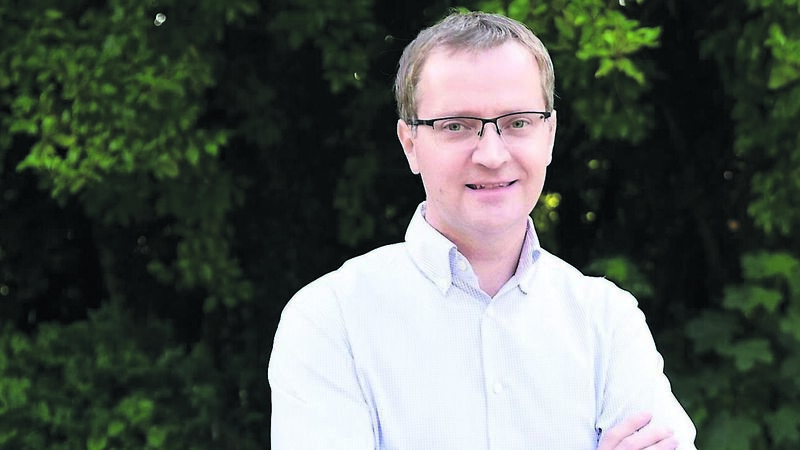Keelvar using sensible supply chain tactics

Alan Holland of Keelvar, an AI supply chain optimisation company based in The Rubicon in MIT. Picture: Victor Horgan Photography
Alan Holland, who spent seven years teaching in the computer science department at UCC, left eight years ago to set up Keelvar, a company that uses Artificial Intelligence and algorithms to figure out the best way to get things from A to B and on to C.
“Sourcing optimisation is our speciality. We use software and algorithms, to find the most efficient win-win decision-making behind getting things from one place to another.”
Mr Holland explained that it is not a straightforward process.
“There are options, you could move things through different ports, you could decide to consolidate your spend with a smaller number of suppliers, but you might have to send it on longer journeys then.
“When you are buying at scale you need this optimisation to figure out what is the more efficient way of doing this.”
He warned that the world is globally facing an “extended period of disruption for the coming years” due to a lack of trust between the ships carrying the goods and the companies shipping the products, along with a lack of investment in new ships and the disruption of the pandemic.
Mr Holland said the hostile environment that exists between shippers and carriers is something that has been festering for some time, but the ongoing pandemic has brought it to a head and resulted in court cases in the US.
“The seeds of this have been set years and years ago really, there was a long period of very low margins for some major transport operators and they haven’t invested, they haven’t been able to invest because many of them have been loss-making for a long time and then as soon as we hit disruption, the collapse in demand at the beginning of the pandemic, they were left nursing losses at the start of Covid because no one was shipping goods and the factories had shut down.”
The Keelvar CEO explained how the pandemic escalated matters so drastically.
“People forget quite quickly, we have excess capacity in ocean transport just 18 months ago, factories were closed and all those vessels were sailing half empty and at huge losses, then demand started bouncing back and what you find is that containers are in the wrong place, because everything moves slowly in ocean freight.
“Companies that had imported stuff just before the pandemic, were holding on to containers in America and Europe, whereas they would normally travel back to Asia for refilling and those vessels went back half empty, so there is a shortage of containers in Asia. They started to manufacture goods again but they couldn’t get them across the seas to the west.
“Then prices started to explode and you then start seeing the carriers getting frustrated with the shippers, because they were left with losses and the shippers, which are retailers and companies, they had very loose contracts with the carriers, designed so that they didn’t have to use the capacity they had. Like booking hotel rooms and not showing up because you didn’t need it in the end.
“So the carriers then when they had demand were looking at bookings they had for shippers who might have negotiated the bookings at low rates and are now saying ‘I don’t like that’ and treating the contracts as loose as the shippers.
“So you have carriers and shippers both looking at this piece of paper saying ‘you know what I’m going to ignore that’. So you have a breakdown in trust and relationships between the carriers and their biggest customers.”
Mr Holland also highlighted that this toxic relationship that exists between the carriers and ships, is stunting the expansion of the industry.
“One of the reasons there has been a lack of investment has been a lack of trust. If you want to build a new ship, it takes years and if you want to invest, you need to look years ahead to justify the investment.”
The supply chain management expert said something needs to give in order to reach a symbiotic relationship between the carriers and the shippers.
“There has to be a change in the contracting relationships between ocean carriers and their biggest customers, so they are thinking in terms of decades as opposed to the next quarter.”
Mr Holland’s company Keelvar, which is pronounced as you would say the Irish word ‘ciallmhar’, which means sensible, works to create a harmony between the two sectors within the industry, by helping companies create win win contracts with shippers.
“Some of the world’s biggest shippers use our software, BMW, Samsung, Siemens, the biggest customers of the ocean carriers, use our software to negotiate with carriers on rates and they can use our software well, if they want to be strategic and negotiate win-win contracts.
“We encourage them to design their contracts so, in times of trouble, you can count on your suppliers to be there for you.”
The company, which is saving a lot of people a lot of headaches, by making sure that money is well spent and profits are enhanced in terms of shipping large amounts of product from one place to another, is in high demand at the moment and leading the way in terms of the technology available to make these decisions.
“In the last 12 months, we have started using AI bots.
“We developed software agents that will source on your behalf finding carriers operating on routes you need, the bot can look at data sources to see the age of the vessel, the co2 emissions and the time it arrives, etc all these things that influence or bias your decision.”
Mr Holland said the supply chain management in sea shipping is becoming more like the algorithms used on Wall Street.
“There seems to be a realisation that companies need to be smarter about their transport, and it can’t be so transactional. If you’re buying week to week, month to month, and always going to the lowest bidder, you are likely to get burnt when times are tough.”
Keelvar CEO said proper relationships need to be built between carriers and shippers.
The former academic said what needs to happen is a change in procedures, away from the ‘just in time’ philosophy which minimised storage and maximised cash flow operations.
“This method is very brittle, there are no buffers, companies need to start hedging.
“Companies need to look at the way they do business and they need to introduce more of a buffer and effectively pay more to hedge their operations.
“Everything moves in cycles, once companies accept they need to do more, things will stabilise but it could take years.”







 App?
App?





